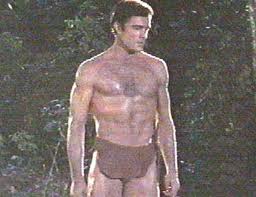In the 1970s, American mass media couldn't get enough of blond preteen boys. Not toddlers, but boys in late childhood, old enough to be cast as adventurous, daring, and mischievous in "boys will be boys" roles. And too young for the pubescent growth spurt that would turn them into yucky androgynous teenagers.
Christopher Shea, born in 1958, is best remembered as the voice of the wise-beyond-his-years Linus in the animated Peanuts specials, especially It's the Great Pumpkin, Charlie Brown (1966).
Linus has always been my favorite Peanuts character: witty, intellectual, rejecting Sally's advances (although he dates a lot of girls in later strips), a good friend to Charlie Brown. And no other voice artist comes closer to capturing his inner beauty than Christopher Shea.
Christopher also did some television work, with guest spots on The Invaders, Green Acres, The Odd Couple, and Here Come the Brides, and a few movies. His last credited role is A Little Game (1971), about a teenager (Mark Gruner) who plots to kill his stepfather.
He moved to Humbolt County, in northern California, where he died in 2010, leaving a wife and two daughters.
His brother Eric, born in 1960, did the usual tv guest spots: Batman, Here Come the Brides, Gunsmoke, The Flying Nun, Room 222 -- but he snared some more substantial movie roles, such as Lucille Ball's son in the big-family comedy Yours, Mine, and Ours (1968) (top photo, the one in the pajamas. The other one is Tim Matheson).
The younger brother of Ben Harvey (Beau Bridges), who gets involved with a clan of prostitutes in Gaily, Gaily (1969).
Kid kid genius Alvin, who solves Cooperstownes with the help of his buddy Shooie (Clay O'Brien) in two Whiz Kids movies (1974, 1976). He also played the Spunky Kid in The Poseidon Adventure (1972).
His last credited role was in When Every Day was the Fourth of July (1978), about a lawyer (Dean Jones) defending a deaf man who has been accused of murder.
Eric has retired from acting and, according to the imdb, works as an electrical contractor in Los Angeles.
![]() I have no pictures of Stephen, born in 1961, since he has only one live screen credit: "Small Boy" on a 1968 episode of Adam-12. But he took on his brother's mantle and voiced Linus in all of the Peanuts animated specials from Play It Again, Charlie Brown (1971) to Be My Valentine, Charlie Brown (1975).
I have no pictures of Stephen, born in 1961, since he has only one live screen credit: "Small Boy" on a 1968 episode of Adam-12. But he took on his brother's mantle and voiced Linus in all of the Peanuts animated specials from Play It Again, Charlie Brown (1971) to Be My Valentine, Charlie Brown (1975).
So I'll give you a pic of one of the many other voice artists who has played Linus over the years, Corey Padnos
See also: Tim Matheson; and The Fabulous Bridges Boys.
Christopher Shea, born in 1958, is best remembered as the voice of the wise-beyond-his-years Linus in the animated Peanuts specials, especially It's the Great Pumpkin, Charlie Brown (1966).
Linus has always been my favorite Peanuts character: witty, intellectual, rejecting Sally's advances (although he dates a lot of girls in later strips), a good friend to Charlie Brown. And no other voice artist comes closer to capturing his inner beauty than Christopher Shea.
Christopher also did some television work, with guest spots on The Invaders, Green Acres, The Odd Couple, and Here Come the Brides, and a few movies. His last credited role is A Little Game (1971), about a teenager (Mark Gruner) who plots to kill his stepfather.
He moved to Humbolt County, in northern California, where he died in 2010, leaving a wife and two daughters.
His brother Eric, born in 1960, did the usual tv guest spots: Batman, Here Come the Brides, Gunsmoke, The Flying Nun, Room 222 -- but he snared some more substantial movie roles, such as Lucille Ball's son in the big-family comedy Yours, Mine, and Ours (1968) (top photo, the one in the pajamas. The other one is Tim Matheson).
The younger brother of Ben Harvey (Beau Bridges), who gets involved with a clan of prostitutes in Gaily, Gaily (1969).
Kid kid genius Alvin, who solves Cooperstownes with the help of his buddy Shooie (Clay O'Brien) in two Whiz Kids movies (1974, 1976). He also played the Spunky Kid in The Poseidon Adventure (1972).
His last credited role was in When Every Day was the Fourth of July (1978), about a lawyer (Dean Jones) defending a deaf man who has been accused of murder.
Eric has retired from acting and, according to the imdb, works as an electrical contractor in Los Angeles.
 I have no pictures of Stephen, born in 1961, since he has only one live screen credit: "Small Boy" on a 1968 episode of Adam-12. But he took on his brother's mantle and voiced Linus in all of the Peanuts animated specials from Play It Again, Charlie Brown (1971) to Be My Valentine, Charlie Brown (1975).
I have no pictures of Stephen, born in 1961, since he has only one live screen credit: "Small Boy" on a 1968 episode of Adam-12. But he took on his brother's mantle and voiced Linus in all of the Peanuts animated specials from Play It Again, Charlie Brown (1971) to Be My Valentine, Charlie Brown (1975).So I'll give you a pic of one of the many other voice artists who has played Linus over the years, Corey Padnos
See also: Tim Matheson; and The Fabulous Bridges Boys.





















































































































